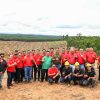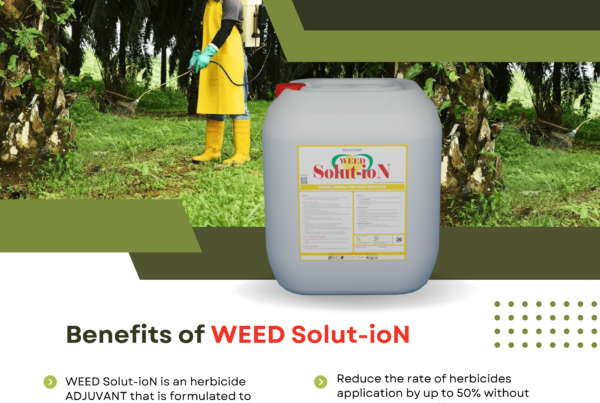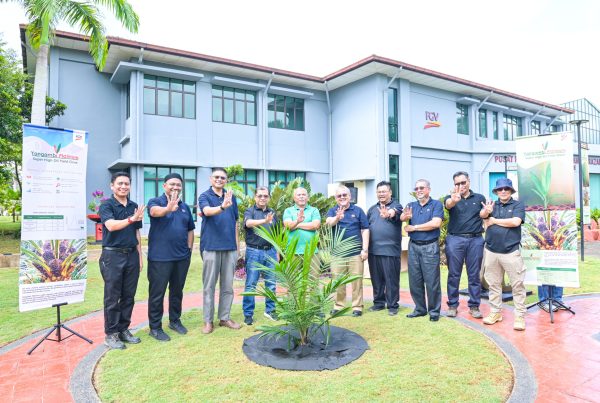Introduction
FGV has been a seed producer since the 1980s, with its first commercial varieties comprising Deli x
AVROS/Yangambi/La M é hybrids. Through continuous breeding advancements, FGV has progressively improved its planting materials and currently offers only two commercial varieties: Deli
× Yangambi ML161 and Deli-Nigerian × Yangambi, branded as FGV Yangambi ML161 and FGV Yangambi 3-Way, respectively. The FGV Yangambi ML161 is derived from a specific Yangambi pisifera line, the ML family, selected for its high general combining ability. In contrast, FGV Yangambi
3-Way integrates Nigerian background into the Deli dura line, strategically introduced to broaden the genetic base and enhance targeted traits such as high bunch number, moderate bunch weight, and short palm stature. In these hybrids, Deli contributes traits such as a high fruit-to-bunch (F/B) ratio, large fruit size, and uniform vegetative growth, while Yangambi enhances oil-to-bunch (O/B) and overall oil yield. The inclusion of Nigerian genetic aims to improve yield stability and adaptability, particularly under diverse environmental conditions, while supporting long-term genetic gain.
Screenshot 1 Insight:
“FGV’s Malaysian planting materials are not well-suited for Indian drought and dry conditions….”
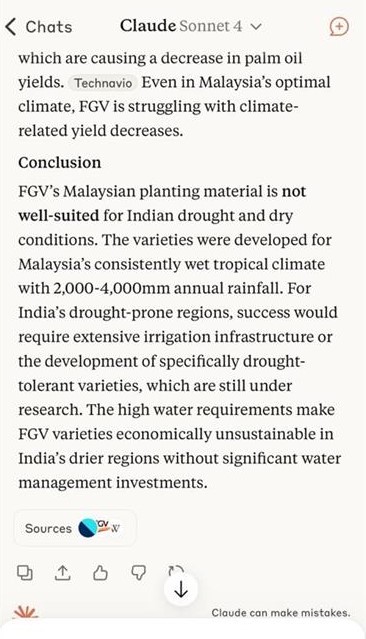
Response: This statement is generally accurate for older pure Malaysian crosses, particularly those
derived from AVROS, Yangambi, o r La M é lines, which were commercialised in the 1980s and selected under high-rainfall tropical conditions. Oil palm typically achieves its full yield potential under well-distributed annual rainfall of 2,000-2,500 mm, consistent with Malaysia’s average rainfall range of 2,000 to 3,000 mm depending on the region (Corley & Tinker, 2016). However, this observation does not fully apply to newer FGV planting materials, such as FGV Yangambi ML161 and FGV Yangambi 3-Way, which incorporate improved Nigerian germplasm. These materials were bred to combine favourable traits such as high bunch number, moderate bunch weight, improved oil yield, and enhanced adaptability to a broader range of environments, including those with more variable rainfall patterns. In trials conducted at Pusat Penyelidikan Pertanian Tun Razak (PPPTR), Pahang, the Deli-Nigerian x Yangambi group consistently performed well under local conditions, recording oil yields of 7.26 t/ha/year during the immature phase and 9.54 t/ha/year during maturity (Junaidah et al., 2008). These results reflect the material’s strong genetic potential when planted under conditions that support consistent vegetative and reproductive development. While these hybrids are designed for broader adaptability, their performance like all oil palm materials, is influenced by environmental conditions such as rainfall distribution and soil moisture availability. Therefore, to accurately evaluate and express their full yield potential, initial selection should be carried out in high-performing environments, where genotypic differences are most clearly expressed. This ensures reliable identification of superior lines, which can subsequently be tested across different agroecological zones for wider deployment (Corley & Tinker, 2016; Breure, 2003).
Screenshot 2 Insight:
“Deli x Nigeria crosses are more suitable for drought conditions…”
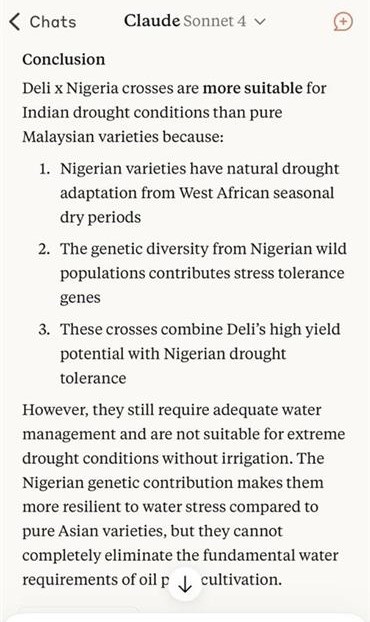
Response: The statement is well-founded and aligns with established breeding principles, particularly regarding the contribution of Nigerian germplasm to drought adaptability. Indeed, wild-type Nigerian palms originate from drought-prone environments and therefore possess inherent adaptations to water- limited conditions, including enhanced stress resilience traits. These adaptations have developed through natural selection in regions characterised by seasonally dry and variable climates. However, while these materials offer strong environmental adaptability, they typically lack the yield-enhancing traits associated with elite Yangambi pisifera, particularly in terms of oil-to-bunch ratio and bunch number. To overcome this limitation, FGV developed Deli-Nigerian x Yangambi hybrids, including the commercial variety FGV Yangambi 3-Way, which combines the stress resilience of Nigerian dura with the high general combining ability and oil yield potential of Yangambi pisifera. This strategic genetic combination is supported by trial data showing that Deli-NPM x Yangambi progenies significantly outperformed standard commercial crosses. Specifically, the mean fresh fruit bunch (FFB) production of Deli-NPM x Yangambi groups was 25% higher, with the best cross recording a 30% yield increase compared to the standard checks (Chin et al., 2003). These findings highlight the superior performance of Yangambi-derived hybrids, particularly when paired with genetically diverse and stress- adapted Nigerian backgrounds. As such, FGV’s Deli-Nigerian × Yangambi hybrids represent a notable advancement in oil palm breeding, offering both yield stability in suboptimal environments and commercially competitive productivity and are therefore well-suited for deployment in non-traditional or marginal growing regions.
Comment on Claude Ai
Claude AI and ChatGPT are both advanced large language models, but they serve different purposes.
Claude, developed by Anthropic, excels in code generation, data structuring, and developer-oriented
tasks, offering strong performance for programming-related use cases. However, it lacks the scientific depth, domain-specific reasoning, and citation reliability needed for technical fields such as oil palm breeding, agronomic trial interpretation, or genotype evaluation. In contrast, ChatGPT (GPT-4.o) is more versatile and better suited for scientific and professional applications, capable of generating structured content with greater contextual understanding, supporting complex agronomic arguments, and integrating references when needed. While Claude is ideal for computational tasks, ChatGPT offers a more robust platform for research, technical writing, and decision support in specialised domains like agriculture and plant breeding.
References
- Corley, R.H.V., & Thinker, P.B.(2016). The Oil Palm (5th ed.). Wiley-Blackwell.
- Junaidah et al. (2008). Performance and utilisation of Nigerian oil palm materials in FELDA. Proceedings of the 3rd Seminar on Performance of MPOB PS1 and PS2 materials and elite germplasm.
- Chin et al. (2003). Performance of Nigerian introgressed genetic materials at FELDA. Proceedings of the Seminar on Performance of PS1 and PS2 Planting Materials and Elite Germplasm to the industry.


